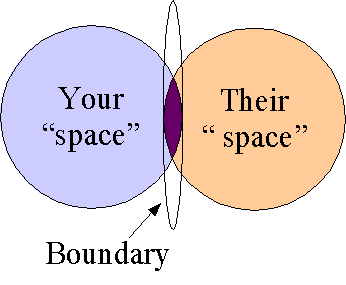Just finished reading, Boundaries Where You End And I Begin: How To Recognize And Set Healthy Boundaries

Follow the link at the bottom for a Christian perspective on boundaries.
One of the things I thought was really creative was how Katherine used her dog and cat as metaphors for explaining “close” and “distant” boundaries, respectively. For example, her dog wants to be around her all the time. Wherever Katherine goes, her dog will stop what he’s doing and follow her, even if he was sound asleep. In this sense, her dog has close boundaries. Her cat, on the other hand, expresses distant boundaries. No matter what Katherine does, her cat will not stop what she’s doing. When Katherine enters the room, for example, the cat will just look at her, but she won’t move. She just lies there. Waiting. Staring. Purring. Unless they want something from you, a cat, for the most part, will ignore you. In many ways, people also set similar boundaries: they’re either far apart where you can’t even connect with them on a personal level, or they’re set too close and you can’t seem to keep them at a healthy distance.
There have been times when I have had to change my boundaries from “close” to “distant.” For example, I was once in a relationship where after a few months, I felt comfortable “letting my guard down” and started to move my boundary closer. Then, without any warning, this person began to say some hurtful things. I felt betrayed. From that point on, I kept very distant boundaries in my relationships. It must have taken me at least a year before I started to practice close boundaries again.
Here are some other lessons I took away from Katherine’s book:
- Our boundaries begin to develop right from infancy. From the time we are born, we rely on our caregivers to shape our first boundaries. Through them, we learn how close others are allowed to be relative to us, and how close we can be towards others. “Don’t talk to strangers,” is an example of how we need to keep a distant boundary with people we don’t know. “Make sure you kiss mommy good night” is an example of how we are taught to keep a close boundary with our parents.
- Boundaries can be physical, emotional, mental, sexual, or spiritual. Our skin is an example of a physical boundary. When it is scratched or broken (a physical injury) we can become ill through an infection. In the same way, when someone crosses our emotional boundary (for example, through verbal abuse), we are also harmed and become emotionally ill. The same thing happens through these other types of boundaries.
- Boundaries can be violated through excessive smothering or neglect. For example, some parents refuse to show any affection to their children. They come across as cold and distant. When this happens, a child’s emotional and physical boundaries are violated by this act of neglect. Some parents can also do the opposite and smother their children, never allowing them to fully experience natural consequences or physical distance. When this happens, children never learn to be independent. They also grow up feeling entitled to emotional or physical intimacy from their partners.
- Boundaries need to be flexible, yet hold their shape. If, for example, we are interacting with a stranger, then it’s important to have more rigidity in our boundary. Once we know the person and feel comfortable with them, it’s important that our boundary become more flexible. Knowing when, and with whom, to do this is an example of being emotionally and mentally healthy.
What have been some of your experiences with boundaries? How do you know when you need to change the boundary in a relationship with someone?
Hoping your relationships are filled with much knowledge, growth, and healthy boundaries….
Dr. Richard Amaral
Here are a couple of links related to this post:
- Anne Katherine’s website. Here, you’ll find more information on the author of Boundaries book and some of her other works.
- Image in this post. I just came across a blog by Mark Wilson where he provides a Christian perspective on boundaries. I really like this image above and enjoyed reading his post.
- Another definition of personal boundary. I came across this website (www.outofthefog.net) in my research for this post. It turned out to be a great find. Just enter “Personal Boundary” on the right as a search term on their website.

